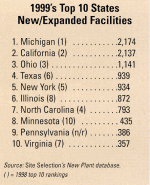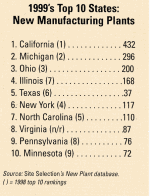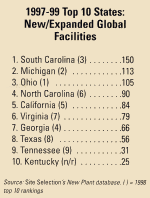
Separated by a statistical nose, Michigan nipped California, as 1999’s record-breaking business expansion clip again demonstrated who went where for maximum site selection value.
Features

And nail gnawing was certainly understandable. This was a bona fide cliffhanger, a donnybrook that swung one way, then the other, before Michigan could finally claim the 1999 Governor’s Cup as the U.S. state with the highest annual total of new corporate facilities and expansions. And Michigan’s winning edge was unprecedented in its narrowness: No. 2 California missed claiming 1999’s crown by an epidermis-thin margin of 0.017 percent. Just how intense was the competition for 1999’s corporate facilities crown? Consider this: Together, Michigan and California accounted for a staggering 4,311 new facilities and expansions — roughly 34 percent of the 12,702 total projects SS tallied for the entire United States during 1999.
Ali vs. Frazier.
Affirmed vs. Alydar.
Borg vs. Conners.
Those kinds of classic confrontations sprang to mind as 1999’s feverish Site Selection Governor’s Cup race wound down. Just like last year, Michigan and California put on a lollapalooza of a showdown, with more than a few state officials gnawing their nails.
Above right: Kings of the Hill – the 1999 Governer’s Cup top 10: Michigan Gov. John Engler (No. 1); California Gov. Gray Davis (No. 2); Ohio Gov. Robert Taft (No. 3); Texas Gov. George W. Bush (No. 4); New York Gov. George Pataki (No. 5); Illinois Gov. George Ryan (No. 6); North Carolina Gov. Jim Hunt (No. 7); Minnesota Gov. Jesse Ventura (No. 8); Pennsylvania Gov. Tom Ridge (No. 9); and Virginia Gov. Jim Gilmore (No. 10).

And that’s saying a business growth mouthful, since 1999’s U.S. total for new facilities and expansions marks a new annual record for Site Selection’s definitive scoreboard. (For the record, 1999’s 12,702 projects marks a 3 percent increase over the previous U.S. record set in 1998).
But hold your tears for California. The Golden State still handily finished No. 1 in 1999 in another closely watched barometer of corporate location action: new manufacturing projects. And its performance in claiming that crown recalled Secretariat’s dizzyingly dominant, 31-length win in the 1973 Belmont Stakes. Similarly, California’s 432 new manufacturing projects were a stunning 46 percent higher than No. 2 Michigan.
1999’s Other No. 1s
Michigan and California, though, were only two of the winners in Site Selection‘s annual expansion scoreboard, long considered the benchmark for business expansion. Other winners identified in SS‘s annual expansion tally included:
A Double Metro “Threepeat”: For an unprecedented third straight year, Detroit again won both metro titles. The Motor City ranked as 1999’s No. 1 metro in total facilities, followed by No. 2 Chicago and No. 3 Orange County, Calif. And Motown also took the crown as 1999’s No. 1 new manufacturing metro, followed by No. 2 Chicago and No. 3 Riverside-San Bernardino, Calif.
A Runaway Regional Champ: In another Secretariat-like statistical showing, the five-state East North Central region was the overwhelming overall 1999 winner among U.S. Census regions. With No. 1 Michigan joined in ’99’s overall top 10 by No. 3 Ohio and No. 6 Illinois, the region totaled a whopping 4,470 new facilities and expansions, almost doubling its nearest competitor, the No. 2 South Atlantic region.
A New No. 1 in International Attraction Action: Mirroring the nation’s record economic surge, global location activity in the United States remained strong, increasing during 1999, albeit by a razor-thin 0.004 percent.
South Carolina, which first burst onto international site selection radar in 1992 by landing BMW’s first U.S. manufacturing facility, is the new No. 1 for global facility attraction, moving up from No. 3 in SS‘s three-year rolling tally. Other major upward movers in 1997-99’s international attraction action include North Carolina, up to No. 4 from No. 6, and No. 10 Kentucky, a top 10 newcomer.
Proportional Perspective Shakes Up Top 10s: As in each scoreboard issue, SS also analyzed expansion with a methodology that levels the playing field in terms of population and landmass. With the accumulated muscle of three straight Governor’s Cup wins, Michigan took No. 1 in three of the four proportional analyses. But as a whole, the proportional analyses revealed a substantially reshuffled order, with some states’ rankings soaring. Kentucky, for example, ranked No. 1 for new jobs per 1 million residents.
Long-Term Leaders — the Joys of Continuity: SS also analyzed state totals through the long-term prism of a three-year rolling tally. But this year’s long-term 1997-99 state analysis reveals no glaring discrepancies from 1999’s order. Michigan, for example, repeated as the long-term leader in overall business expansion. But California, atop its stellar 1999 showing, speed-surfed over Michigan to become the new No. 1 in long-term new manufacturing.
A Millennial Gaze into the Expansion Crystal Ball: Armed with a long history of accurately presaging business expansion trends, the Site Selection Index enters the new millennium by projecting 2000 as another strong year for new facility activity, with 20 percent growth.
Here are capsule looks at 1999’s 10 states in the Governor’s Cup contest:
No. 1 Michigan
An apt metaphor for Michigan’s rebirth? Try DaimlerChrysler’s massive 1 million-sq.-ft. (92,900-sq.-m.) engine plant on Detroit’s Mack Avenue, located on a once abandoned, polluted site in a tax-free Michigan Renaissance Zone. After its $1 billion refurbishment, the facility won a prestigious National Award for Sustainability from the President’s Council on Sustainable Development.

A restored auto plant at a location that governmental resourcefulness reinvented: That encapsulates a lot of Michigan’s Governor’s Cup-winning magic.
Burdened in the ’80s with the highest U.S. unemployment rate, a once blemished business climate keeps adding gloss, most recently with late 1999’s $200 million unemployment tax cut.
“Michigan’s surging economy is not only producing record low unemployment, but is also generating significant employer tax savings,” said Gov. John Engler. “For the fifth straight year, we are cutting unemployment taxes.”
In fact, Michigan’s 26 tax cuts since 1991 have totaled $11 billion, a pro-business slant that undoubtedly fueled many of the state’s major 1999 deals.
Above right: Lansing is home to not only Michigan’s aggressive state economic development team. It will also be home to GM’s new $450 million, 2,000-employee facilty, which auto manufacturing facility, the first built in the state since 1982.
DaimlerChrysler, for example, made two more Detroit-metro major moves: a new $750 million auto parts facility and a new $80 million office near its North American headquarters.
But even bigger news came with General Motors’ new $450 million, 2,000-employee auto facility in Lansing. Lured in part by $99 million in incentives, the new auto plant will be the first built in the state since 1982.
Clearly, record U.S. sales in the auto industry, still the state’s economic turbocharger, catalyzed Michigan’s 1999 success. (In fact, manufacturing deals made up 44 percent of Michigan’s 1999 total.)
But Michigan’s standard-setting ’99 also reflects a diversification led by high tech, the state’s fastest growing sector, as exemplified by Compuware’s new 6,500-employee headquarters in a 14-story, pentagon-shaped Detroit tower.
Famous for its furniture, the Grand Rapids-Muskegon-Holland metro also stayed strong, ranking No. 7 in both overall facilities and new manufacturing. Among the metro’s major deals were Steelcase’s new $34 million plant and Delphi Automotive Systems’ $25 million manufacturing expansion.
Perhaps Michigan’s aptly named Renaissance Zones best summarize its success. In three years, they’ve landed some 130 firms, 3,700 new jobs and $330 million in new investment.
“The idea for the Renaissance Zones was that eliminating taxes could jump-start business growth,” explained Michigan Economic Development Corp. (www.medc.michigan.org) President Doug Rothwell. “We got that boost. This program has become one of the country’s most successful initiatives.”
And so has Michigan.
No. 2 California
It was a deal befitting a big cheese in business attraction: As 2000 dawned, Leprino Foods announced that Lemoore, Calif., had landed the world’s largest mozzarella cheese operation, a 400-employee, $150 million facility. “This is a tremendous shot in the arm for Kings County,” said Lon Hatamiya, secretary of the California Trade and Commerce Agency (www.commerce.ca.gov), “and it’s an example of California opening its doors to new business expansions.”
Indeed, a veritable expansion Gold Rush flew through California’s doors last year, with four metros ranked in both of 1999’s top 10s: Los Angeles-Long Beach, Orange County, Riverside-San Bernardino and San Diego. And Los Angeles bagged ’99’s biggest U.S. project, the 2.8 million-sq.-ft. (260,100-sq.-m.) North Hollywood Studio Complex, built to blunt an entertainment industry exodus.

Hot-wired action was also abundant in Silicon Valley, likely the world’s largest brainpower cluster, including Cisco Systems’ $110 million Milpitas expansion, Yahoo’s 400-employee Santa Clara headquarters expansion and Canon USA’s new $30 million San Jose headquarters. Peregrine Systems’ new $175 million Del Mar headquarters marked another big peak on California’s expansion seismograph. Even George Lucas was with California’s ’99 force, siting a $250 million, 1,500-employee corporate campus in San Francisco’s Presidio.
And the state Fast Company dubbed “Free Agent Nation” ended 1999 with another big bang. On Dec. 27, after SS’s final ’99 scoreboard was put to bed, Palmdale Regional Airport landed Swiss-based SR Technics’ 6,000-employee North American aircraft maintenance headquarters.
Commented Gov. Gray Davis, “The aerospace industry fueled the growth of California, and the arrival of industries like SR Technics is part of a new blueprint for 21st century prosperity.”
Indeed, that coup already sets one high blueprint standard. It’s California’s biggest foreign investment in 10 years.
No. 3: Ohio
The architect of its own ’93-95 Governor’s Cup “threepeat,” Ohio remains a potent force.
“We are enjoying some of the best economic times Ohio has seen,” asserted Gov. Robert Taft, who continues the enterprising economic development drives championed by George Voinovich, now a U.S. senator.
1999’s No. 3 new manufacturing state, Ohio landed showcase industrial deals that included Whirlpool’s $92 million expansion in Findlay and PPG Industries’ $74 million expansion in Cleveland.
Manufacturing remains Ohio’s economic mainstay, and the state flexed particularly strong auto-sector muscle. 1999’s major deals included the $535 million Ford/ZF Batavia joint venture in Batavia; Ford’s $154 million expansion in Cincinnati; DaimlerChrysler’s $150 million expansion in Akron, Delphi Automotive’s $104 million expansion in Dayton and GM’s $80 million expansion in Lima.
Ohio’s intermodal infrastructure and central U.S. location also spurred a distribution facility deluge, including Emery Worldwide’s $300 million expansion in Dayton, Isuzu America’s new $88 million facility in Cincinnati and Dollar General Stores’ new $61 million operation in Washington Township. Ohio’s long distribution-facility parade also included AC Delco, Best Buy, BF Goodrich, Coca-Cola, DaimlerChrysler, General Mills, GM (the state’s largest employer), PetSmart, PPG and Whirlpool.
In addition, Ohio’s strong plastics sector stretched out in ’99, with Crane Plastics, Polar Minerals and Rubbermaid all announcing major expansions.
Besides facilitating expansions by Buckeye-based firms like BF Goodrich and Rubbermaid, Ohio also retained Abercrombie & Fitch (A&F). After being avidly courted, particularly by neighboring Indiana, A&F chose Columbus as the site of its substantially expanded $120 million, 1,100-employee headquarters.
Industry analysts say part of Ohio’s continuing success lies in the innovative economic development partnerships between local and regional agencies and the Ohio Dept. of Development (www.odod.ohio.gov), headed by director C. Lee Johnson.
Indeed, the home of the inventors of manned flight and the light bulb still seems to have a few more business attraction tricks up its sleeve.
No. 4 Texas
Appropriately, the Lone Star State’s big year included a truly Texas-size deal: Sabre’s 9,000-employee, $417 million headquarters complex in Southlake in the Fort Worth metro, 1999’s largest U.S. job generator; and employment may expand to 15,000 by 2008.
Manufacturing deals were key in Texas’s success, many of them technology-intensive, a trend Gov. George W. Bush further encouraged with ’99’s passage of a $70 million R&D tax credit (part of the state’s $506 million tax cut). 1999’s No. 5 new manufacturing state, Texas landed Dell Computers’ 5,000-employee expansion, Computer Science Corp.’s 2,000-employee expansion and Motorola’s $100 million expansion, all in the Austin metro; Ericsson’s new 1,700-employee manufacturing/office operation in the Dallas metro and General Motors’ 500-employee truck manufacturing expansion in Fort Worth.

The state also bagged numerous high-end office projects, many landing in 1999’s No. 10 metro, Dallas, including Chase Manhattan’s new 1,600-employee center, i2 Technologies’ 3,000-employee expansion and Microsoft’s 1,200-employee expansion. Next-door Fort Worth was also fertile turf for big office deals, including Ameritrade’s new 1,200-employee operation and Aetna U.S. Healthcare’s 900-employee expansion.
Some of the Old West, though, endured among the bevy of New South-flavored investments. 1999’s major deals in the state’s long-strong petroleum and chemical industries, for example, included Clark Refining’s $775 million expansion and Fina/Shell Chemical/BASF’s $200 million expansion, both in Port Arthur, and Exxon Mobil’s new 2,000-employee office in Houston.
Likely NAFTA’s biggest beneficiary, Texas is now No. 8 in landing international expansions, with 1999’s action including Samsung Electronics’ $250 million Austin expansion. European firms have also become particularly important, says Jeff Moseley, Texas Dept. of Economic Development (www.tded.state.tx.us) executive director.
“European companies are increasingly becoming a crucial partner,” explains Moseley. “Texas exports to the European Union reached a record $9.7 billion in 1998.”
No. 5 New York
You didn’t have to be a U.S. Senate hopeful in 1999 to learn a lot about New York business expansion. The Empire State’s success was hard to miss.
Unsurprisingly, New York City, 1999’s No. 5 overall metro, played a starring role. The city landed a number of mega-deals reflecting its global finance clout, including three major headquarters: the New York Stock Exchange’s new $440 million facility, Bear Stearns’ new 1.2 million-sq.-ft. (111,400-sq.-m.) operation and Ernst & Young’s 6,000-employee expansion. The latter deal provided an exclamation point for the uncommon success in redeveloping Times Square, where Home Box Office also inked a 20-year, $250 million lease last year.
But New York City was only part of the action. 1999’s No. 6 new manufacturing state, New York also landed two major projects for homegrown IBM, a $51 million Fishkill expansion and a 263-employee Albany-metro expansion. The state’s other important industrial deals included 3M’s $35.2 million Buffalo-metro expansion; BT Raymond’s 300-employee forklift operation Greene expansion and the New York Post‘s $201 million printing plant expansion.
New York’s high-tech push also reaped rewards, including AlliedSignal’s $48 million R&D expansion in Buffalo. Spurred by a contract to build 6,000 U.S. Post Office vehicles, Ford is also adding 300 employees at its electric-car manufacturing plant in Rome. Gov. George Pataki commented at the Ford announcement, “This is a huge contract that we can build on to make this region the focal point for emerging high-tech industries like electric and hybrid vehicles.”
Finally, New York’s small businesses also flourished in 1999. In fact, the state’s Small Business Division was designated as a “Vision 2000 Model of Excellence” by the U.S. Small Business Administration.
Commented Charles Gargano, Empire State Development (www.empire.state.ny.us) chairman, “Gov. Pataki’s economic development programs and polices are again being held up as a national example. . . New York’s economy has gained 544,600 new private sector jobs since 1995.”